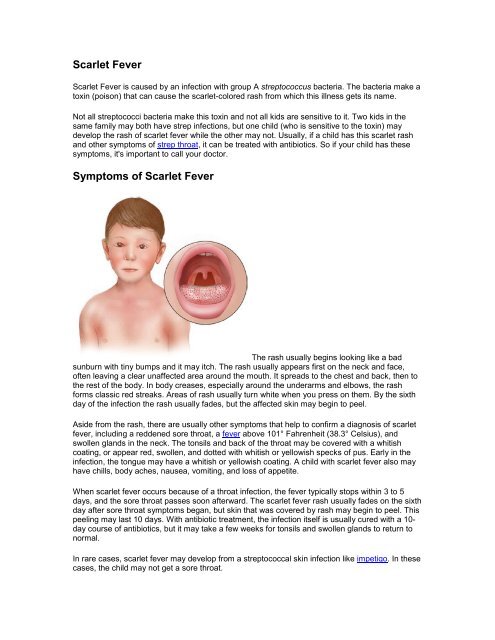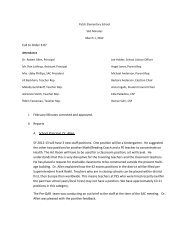Scarlet Fever Symptoms of Scarlet Fever - Patch Elementary School
Scarlet Fever Symptoms of Scarlet Fever - Patch Elementary School
Scarlet Fever Symptoms of Scarlet Fever - Patch Elementary School
- No tags were found...
Create successful ePaper yourself
Turn your PDF publications into a flip-book with our unique Google optimized e-Paper software.
<strong>Scarlet</strong> <strong>Fever</strong><strong>Scarlet</strong> <strong>Fever</strong> is caused by an infection with group A streptococcus bacteria. The bacteria make atoxin (poison) that can cause the scarlet-colored rash from which this illness gets its name.Not all streptococci bacteria make this toxin and not all kids are sensitive to it. Two kids in thesame family may both have strep infections, but one child (who is sensitive to the toxin) maydevelop the rash <strong>of</strong> scarlet fever while the other may not. Usually, if a child has this scarlet rashand other symptoms <strong>of</strong> strep throat, it can be treated with antibiotics. So if your child has thesesymptoms, it's important to call your doctor.<strong>Symptoms</strong> <strong>of</strong> <strong>Scarlet</strong> <strong>Fever</strong>The rash usually begins looking like a badsunburn with tiny bumps and it may itch. The rash usually appears first on the neck and face,<strong>of</strong>ten leaving a clear unaffected area around the mouth. It spreads to the chest and back, then tothe rest <strong>of</strong> the body. In body creases, especially around the underarms and elbows, the rashforms classic red streaks. Areas <strong>of</strong> rash usually turn white when you press on them. By the sixthday <strong>of</strong> the infection the rash usually fades, but the affected skin may begin to peel.Aside from the rash, there are usually other symptoms that help to confirm a diagnosis <strong>of</strong> scarletfever, including a reddened sore throat, a fever above 101° Fahrenheit (38.3° Celsius), andswollen glands in the neck. The tonsils and back <strong>of</strong> the throat may be covered with a whitishcoating, or appear red, swollen, and dotted with whitish or yellowish specks <strong>of</strong> pus. Early in theinfection, the tongue may have a whitish or yellowish coating. A child with scarlet fever also mayhave chills, body aches, nausea, vomiting, and loss <strong>of</strong> appetite.When scarlet fever occurs because <strong>of</strong> a throat infection, the fever typically stops within 3 to 5days, and the sore throat passes soon afterward. The scarlet fever rash usually fades on the sixthday after sore throat symptoms began, but skin that was covered by rash may begin to peel. Thispeeling may last 10 days. With antibiotic treatment, the infection itself is usually cured with a 10-day course <strong>of</strong> antibiotics, but it may take a few weeks for tonsils and swollen glands to return tonormal.In rare cases, scarlet fever may develop from a streptococcal skin infection like impetigo. In thesecases, the child may not get a sore throat.
Preventing <strong>Scarlet</strong> <strong>Fever</strong>The bacterial infection that causes scarlet fever is contagious. A child who has scarlet fever canspread the bacteria to others through nasal and throat fluids by sneezing and coughing. If a childhas a skin infection caused by strep bacteria, like impetigo, it can be passed through contact withthe skin.In everyday life, there is no perfect way to avoid the infections that cause scarlet fever. When achild is sick at home, it's always safest to keep that child's drinking glasses and eating utensilsseparate from those <strong>of</strong> other family members, and to wash these items thoroughly in hot soapywater. Wash your own hands frequently as you care for a child with a strep infection.Treating <strong>Scarlet</strong> <strong>Fever</strong>If your child has a rash and the doctor suspects scarlet fever, he or she will usually take a throatculture (a painless swab <strong>of</strong> throat secretions) to see if the bacteria grow in the laboratory. Once astrep infection is confirmed, the doctor will likely prescribe an antibiotic for your child to be takenfor about 10 days.Caring for a Child With <strong>Scarlet</strong> <strong>Fever</strong>A child with severe strep throat may find that eating is painful, so providing s<strong>of</strong>t foods or a liquiddiet may be necessary. Include soothing teas and warm nutritious soups, or cool s<strong>of</strong>t drinks,milkshakes, and ice cream. Make sure that the child drinks plenty <strong>of</strong> fluids.Use a cool-mist humidifier to add moisture to the air, since this will help soothe the sore throat. Amoist warm towel may help to soothe swollen glands around your child's neck.If the rash itches, make sure that your child's fingernails are trimmed short so skin isn't damagedthrough scratching.When to Call the DoctorCall the doctor whenever your child suddenly develops a rash, especially if it is accompanied by afever, sore throat, or swollen glands. This is especially important if your child has any <strong>of</strong> thesymptoms <strong>of</strong> strep throat, or if someone in your family or in your child's school has recently had astrep throat.If you have any questions related to this matter, please feel free to contact me atKA, RN<strong>School</strong> Health Nurse0711-680-4030















